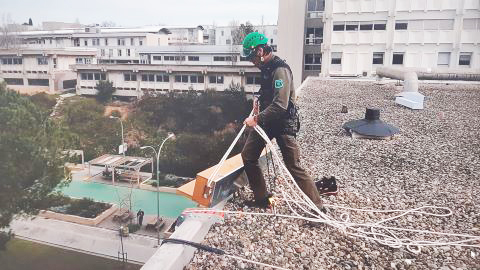The UAB instals bird nests for swifts inside the faculties' shutter boxes
The UAB has installed four custom-made nest boxes to house both swifts and bats on the facade of the Science and Technology Library. They have been placed right in front of the windows where some swifts had nested in recent years, inside the shutter boxes. In this way, the renovation of the windows will not affect this species, which will find an alternative nesting possibility, thus protecting the biodiversity of the campus.

Since 2015, the UAB annually monitors some 30 swift nests located at the Faculty of Science and Biosciences, and has ringed 237 swifts. It is estimated that some 80 to 90 nests can be found on campus, inside the shutter boxes of different faculties.
The four nest boxes were installed on Thursday 27 February, before the nesting period in the spring, and offer a solution that benefits two key species of the ecosystem and biodiversity hosted by the Bellaterra campus of the UAB. Three nest boxes have been installed near the original nests and the fourth (as a pilot test) near a window not yet replaced. The UAB annually monitors the approximately 80 to 90 active swift nests that are believed to exist in the university buildings' shutter boxes.
These nest boxes, specifically manufactured by the company Ecotonos, measure 150 × 19.5 × 26 mm and are made of wood. The lid includes a galvanised steel drawer and a top register for easy maintenance. Inside there are three central spaces for swifts and an additional 22 mm space between the box and the wall for bats. They are designed so that both swifts and bats can easily enter and nest inside. The color of the nest boxes was decided by a vote among the university community.
The installation of the nest boxes was carried out with the collaboration of the Mountain Support Group of the Rural Agents Corps, providing technical expertise to the project, and a protocol was established for similar future actions. The rural agents had to hang and climb down the facade in order to install the boxes.
With this initiative, the UAB aims to protect the biodiversity of its campus while improving the energy efficiency of its buildings. The plan to improve the acoustic and thermal conditions of the buildings includes the replacement of original windows and shutters (in many of which swifts had nested). Therefore, the UAB took measures to safeguard the bird species nesting in its facilities and decided to build the nest boxes.
Initially, it was believed that the changes would only affect two swift nests, but banding on 1 July 2024 revealed that three were affected.
Ecological importance
The black swift (Apus apus), a protected species that nests on campus, plays a crucial role in controlling insect populations by consuming large numbers of mosquitoes and other flying insects. They are essential in maintaining the ecological balance of urban environments. Their presence not only enriches the biodiversity of the campus, but also contributes to natural pest control. Bats, in addition to consuming large quantities of insects, also contribute to pollination and seed dispersal.
Monitoring and conservation
Thanks to a pilot test in 2014, since 2015 the UAB has been monitoring about thirty swift nests annually at the Faculty of Sciences and Biosciences, banded 237 birds and carried out six recoveries.
In 2023, as part of a UAB collaboration with AVAFES (Association of Veterinarians for the Care of Exotic and Wild Fauna), a camera was installed inside a swift nest and the complete breeding cycle of this bird was observed. The pilot test allowed to obtain interesting images of the arrival of the swifts to the nest, the postnest and the birth of two chicks. In the blog ja.cat/falciot you can find the most relevant moments.
Balancing efficiency and biodiversity
This project highlights the need to find a balance between energy efficiency and the preservation of urban biodiversity. “Identifying the nests is not easy and has been done thanks to years of on-site visits,” explains Anna Florensa, a technician at the Sustainability Office. In this sense, it is estimated that there are between eighty and ninety active nests on campus, mainly in Building C (faculties of Science and Biosciences), followed by Building B, and very occasionally in Building M (Medicine) and Building A (Rectorat).
The University will continue to periodically monitor the nest boxes to evaluate the effectiveness of the measures implemented, thus reaffirming its commitment to sustainability and biodiversity conservation.
In addition to swifts, it has been verified that other protected species nest on the Bellaterra campus, such as the common buzzard, the swallow, and the kestrel, but so far only swifts and buzzards have been found to nest inside the shutter boxes.